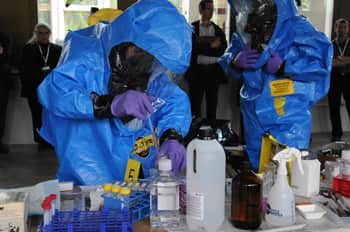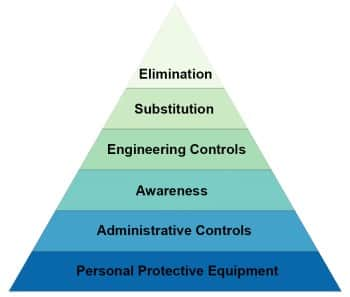Minimizing Risks from Hazardous Materials
Hazardous Materials Risks
Throughout the U.S., there are thousands of Hazardous Materials (HAZMAT) that are manufactured, processed, transported, handled, and used every day across numerous industries and workplaces. There are many U.S. regulatory agencies that mandate compliance requirements for these hazardous materials. Among them are the Occupational Safety and Health Administration (OSHA), Department of Transportation (DOT) and the Environmental Protection Agency (EPA). Employers whose operations involve hazardous materials must be knowledgeable and comply with applicable federal, state, and local regulatory requirements. When it comes to minimizing risks from hazardous materials for employees, a great starting point can be found within the first few sections of the OSHA HAZWOPER Standard.
HAZWOPER Sections (b) through (e)
OSHA General Industry Regulations 29 CFR 1910.120, Hazardous Waste Operations and Emergency Response, HAZWOPER Sections (b) through (e) contain the following information:
Section (b) - Safety and Health Program: Safety and health programs are the building blocks of an organization's ability to minimize, reduce, or eliminate hazards and risks associated with hazards. The goal of the programs is to prevent workplace injuries, deaths, and illness, as well as any hardship associated with these events. In OSHA's own words, “this program shall be designed to identify, evaluate, and control safety and health hazards, and provide for emergency response for hazardous waste operations.”OSHA's Recommended Practices for Safety and Health Programs website identifies seven core elements to follow when developing a safety and health program:
1. Management Leadership
2. Worker Participation
3. Hazard Identification and Assessment
4. Hazard Prevention and Control
5. Education and Training
6. Program Evaluation and Improvement
7. Communication and Coordination for Host Employers, Contractors, and Staffing Agencies

As Section (b) points out, it is not only important to establish a company-wide safety and health program, but also to develop and implement site-specific safety plans that address specific hazards on the site that workers may encounter, and how best to mitigate them. Once these written procedures are documented and communicated to employees, proper analysis of the worksite itself is required.
Section (c) - Site Characterization and Analysis: Aside from basic information about the site such as location, operation activities and duration of those activities, all suspected conditions that may pose inhalation or skin absorption hazards that are immediately dangerous to life or health (IDLH), or other conditions that may cause death or serious harm, shall be identified during the preliminary survey and evaluated during the detailed survey.
Risk identification is covered in section (c)(7), which clearly indicates:"Once the presence and concentrations of specific hazardous substances and health hazards have been established, the risks associated with these substances shall be identified. Employees who will be working on the site shall be informed of any risks that have been identified. Risks to consider include, but are not limited to:
- Exposures exceeding the permissible exposure limits and published exposure levels.
- IDLH Concentrations.
- Potential Skin Absorption and Irritation Sources.
- Potential Eye Irritation Sources.
- Explosion Sensitivity and Flammability Ranges.
- Oxygen deficiency."
Section (d) - Site Control: Once hazards have been identified, and before work begins, it is necessary to control these hazards. A site control program may be basic or complex, depending on the level of control required. However, the elements of the site control program, at a minimum, shall include:
- Site map
- Site work zones
- Use of a "buddy system"
- Site communications including alerting means for emergencies
- Standard operating procedures or safe work practices
- Identification of the nearest medical assistance
Section (e) - Training:Initial and refresher safety and health training for employees are a critical part of both overall compliance and hazard control. No employee shall ever be permitted to participate in or supervise activities until they have been trained to a level required by their job function and responsibility. The training shall thoroughly cover the following:
- Names of personnel and alternates responsible for site safety and health
- Safety, health, and other hazards present on the site
- Use of personal protective equipment (PPE)
- Work practices by which the employee can minimize risks from hazards
- Safe use of engineering controls and equipment on the site
- Medical surveillance requirements including recognition of symptoms and signs which might indicate over exposure to hazards
- Other applicable topics such as decontamination procedures, emergency response, confined space entry procedures and spill containment

Hierarchy of Controls
Those familiar with the traditional process of controlling hazards should notice the direct correlation with the above sections. The fundamental method of protecting workers is controlling exposures to occupational hazards. A hierarchy of controls is used as a means of determining how to implement feasible and effective control solutions. This top/down approach suggests the following:
Elimination: Physically removing hazards
Substitution: Replacing the hazards
Engineering Controls: Isolating workers from the hazards
Administrative Controls: Changing or improving the way people work
Personal Protective Equipment: Protecting workers with PPE
In summary, the hierarchy suggests elimination, substitution, and engineering controls are potentially more effective and protective of controlling hazards than administrative controls and personal protective equipment.
For more information, employers should review the hierarchy page from the National Institute for Occupational Safety and Health (NIOSH) website.

